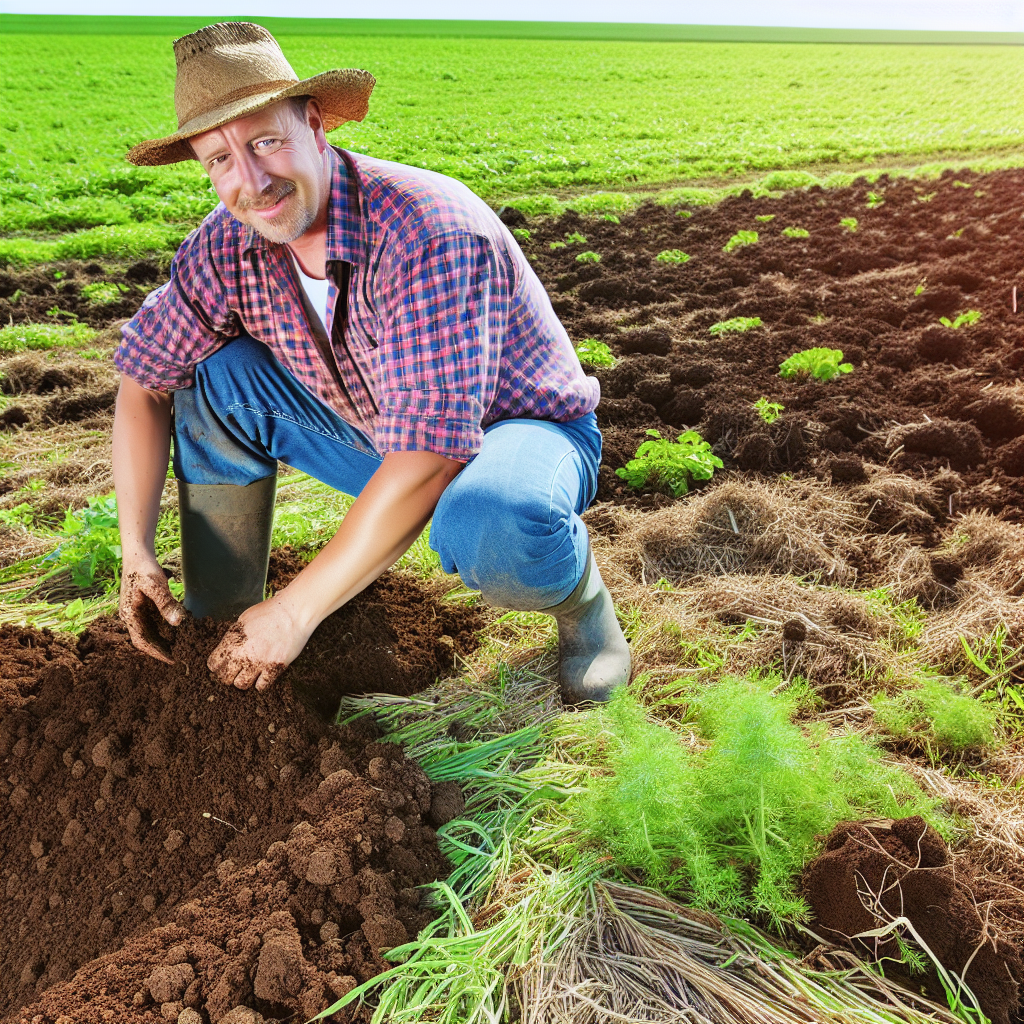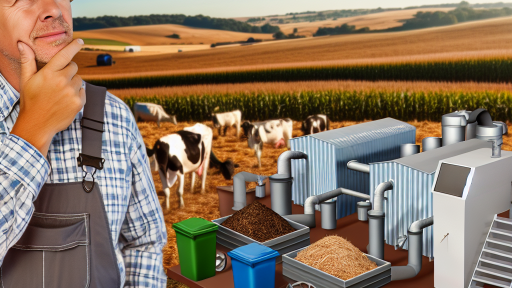Introduction to Organic Farming and Its Importance for Soil Health
Organic farming emphasizes sustainable practices that protect the environment.
This method enhances soil health through natural processes.
Healthy soil is crucial for growing nutritious crops.
Moreover, organic farming promotes biodiversity in agroecosystems.
It helps in maintaining the balance of microorganisms in the soil.
These microorganisms play a vital role in nutrient cycling.
In contrast, conventional farming methods often harm soil quality.
They rely heavily on chemical fertilizers and pesticides.
This reliance can degrade soil structure and fertility over time.
Organic practices enrich the soil’s organic matter content.
For instance, composting contributes to improved soil fertility.
Additionally, cover cropping prevents soil erosion and nutrient loss.
These practices foster a resilient ecosystem for agricultural purposes.
Furthermore, organic farming reduces the risk of chemical runoff.
This consequently protects water quality and the surrounding environment.
Transform Your Agribusiness
Unlock your farm's potential with expert advice tailored to your needs. Get actionable steps that drive real results.
Get StartedAs a result, organic farms can contribute positively to overall ecosystem health.
Investing in soil health through organic methods ensures longevity for agriculture.
Farmers must understand the critical relationship between soil health and crop production.
Empowering farmers with knowledge can help them adopt sustainable practices.
Ultimately, healthier soils can lead to better food security for communities.
Understanding Soil Health
Key Indicators of Soil Health
Soy health is vital for sustainable agriculture.
Key indicators include organic matter content, nutrient availability, and biodiversity.
Organic matter improves soil structure and moisture retention.
Nutrient availability supports plant growth and increases crop yields.
Biodiversity promotes resilient ecosystems and pest management.
Benefits of Healthy Soil
Healthy soil contributes to higher agricultural productivity.
It reduces the need for chemical fertilizers and pesticides.
Moreover, it enhances water filtration and reduces erosion.
Healthy soil increases carbon sequestration, mitigating climate change.
Ultimately, it supports food security for future generations.
Measuring Soil Health
Farmers can assess soil health through various tests.
Laboratories provide analyses of nutrient levels and pH balance.
Additionally, visual inspections reveal soil texture and structure.
Regular monitoring helps track changes in soil health over time.
Ultimately, understanding these measurements guides management decisions.
Cover Crops: Enhancing Soil Fertility and Reducing Erosion
Introduction to Cover Crops
Cover crops are plants grown primarily for soil improvement.
They offer numerous benefits, especially in organic farming.
Farmers use them to enhance soil health and reduce erosion.
Overall, cover crops are vital in sustainable agricultural practices.
Showcase Your Farming Business
Publish your professional farming services profile on our blog for a one-time fee of $200 and reach a dedicated audience of farmers and agribusiness owners.
Publish Your ProfileBenefits of Cover Crops
One significant advantage is soil fertility enhancement.
Cover crops can fix nitrogen, benefiting subsequent crops.
For example, legumes enrich the soil with nitrogen compounds.
Additionally, they contribute organic matter to the soil.
This organic matter improves soil structure and water retention.
Preventing Erosion
Cover crops play a crucial role in preventing soil erosion.
Their root systems hold soil in place, especially on slopes.
Furthermore, they reduce surface runoff during heavy rains.
This helps maintain soil integrity and prevents nutrient loss.
Types of Cover Crops
- Leguminous crops: These include clover and vetch.
- Grasses: Rye and oats are common choices.
- Brassicas: Rapeseed and mustard are effective as well.
Best Practices for Utilizing Cover Crops
Farmers should select appropriate cover crops based on their goals.
Timing is essential; planting should occur in the off-season.
Additionally, proper termination of cover crops is crucial.
This ensures they do not compete with cash crops for nutrients.
Moreover, integrating cover crops into crop rotations maximizes benefits.
Case Studies and Success Stories
A study by Greenfield Farms showed notable improvements in soil health.
They reported enhanced fertility and reduced erosion rates.
Another example is the success of Riverbend Organic Farm.
They implemented a cover cropping system, leading to increased yields.
Farmers can learn valuable lessons from these case studies.
Importance of Cover Crops
Cover crops are essential for enhancing soil health.
They improve fertility, reduce erosion, and provide ecological benefits.
Farmers adopting these practices ensure sustainable agriculture.
Ultimately, cover crops contribute to a healthier planet.
Uncover the Details: Biodiversity’s Role In Sustainable Soil Health
Composting Practices: Improving Soil Structure and Nutrient Availability
Understanding Composting
Composting involves the natural decomposition of organic materials.
This process transforms waste into valuable soil amendments.
As a result, compost enriches soil structure and fertility.
Benefits of Composting
Composting improves soil aeration and drainage.
It enhances the water retention capacity of the soil.
Moreover, compost enriches soil with essential nutrients.
These nutrients promote healthy plant growth.
Choosing Materials for Compost
Use a mix of green and brown materials in your compost pile.
Greens include kitchen scraps and grass clippings.
Browns consist of dried leaves, straw, and cardboard.
A balanced mix accelerates the decomposition process.
Composting Methods
Consider using a traditional compost bin.
Alternatively, a tumbler can speed up the process.
Worm composting is also an effective method.
Each method offers unique benefits for soil health.
Managing the Compost Pile
Regularly turning the compost pile is crucial.
Showcase Your Farming Business
Publish your professional farming services profile on our blog for a one-time fee of $200 and reach a dedicated audience of farmers and agribusiness owners.
Publish Your ProfileThis helps aerate the materials and speeds up decomposition.
Moreover, maintaining the right moisture level is essential.
Ideal moisture keeps microorganisms active and healthy.
Using Compost in Your Garden
Incorporate compost into your garden beds.
This practice improves soil structure and water retention.
You can also use compost as a top dressing for plants.
Additionally, compost tea can be sprayed on plants for extra nutrients.
Composting Challenges
Composting can lead to unpleasant odors if not managed properly.
Ensure sufficient airflow and balance of materials.
Pests can also be a concern; using a closed bin helps.
By addressing these issues, you can maintain an effective compost system.
Explore Further: Precision Irrigation Systems for Modern Farms
Crop Rotation: Diversifying Planting Cycles for Better Soil Ecology
Introduction to Crop Rotation
Crop rotation is a vital practice in organic farming.
This method enhances soil health by alternating different crops.
It prevents soil nutrient depletion and supports diverse ecosystems.
Benefits of Crop Rotation
First, crop rotation reduces pest and disease outbreaks.
Certain crops can inhibit pests that harm others.
Additionally, this practice improves soil structure over time.
Planting different crops increases organic matter in the soil.
Types of Crop Rotation
There are several approaches to crop rotation.
Cover cropping is one effective method.
In this system, crops stay in the field during off-seasons.
It protects soil from erosion and adds nutrients.
Alternate Cropping
Alternate cropping involves switching crops each season.
This diversity prevents soil-borne diseases.
For example, planting legumes one year enhances nitrogen levels.
Sequence Planting
Sequence planting refers to the order in which crops are planted.
First, a heavy feeder like corn is grown.
Next, a lighter feeder like beans follows.
This method ensures balanced nutrient requirements.
Implementing Crop Rotation
Farmers should plan rotations based on local climate and soil type.
Consulting with soil experts helps determine needs.
Some farmers keep records to evaluate their practices.
Challenges of Crop Rotation
Crop rotation can present certain challenges.
Limited space may restrict the variety of crops grown.
In some cases, not all farmers are familiar with the practice.
Education and resources can mitigate these issues.
The Importance of Crop Rotation
Crop rotation significantly enhances soil health.
This method combats pests and diseases while enriching soil.
Implementing diverse planting cycles is beneficial for sustainability.
Showcase Your Farming Business
Publish your professional farming services profile on our blog for a one-time fee of $200 and reach a dedicated audience of farmers and agribusiness owners.
Publish Your ProfileFind Out More: Reducing Carbon Footprint with Sequestration in Agriculture

Reduced Tillage: Minimizing Soil Disturbance and Preserving Microbial Life
Understanding Reduced Tillage
Reduced tillage is an essential organic farming practice.
This method minimizes soil disturbance during cultivation.
It focuses on maintaining the structure and integrity of the soil.
Furthermore, this practice preserves microbial life within the soil.
Benefits of Reduced Tillage
Reduced tillage enhances soil health and fertility.
It increases organic matter, improving nutrient retention.
This method also promotes better water infiltration and retention.
Additionally, it results in less erosion and runoff of topsoil.
Microbial Life and Soil Health
Microbial life is vital for a healthy ecosystem.
These organisms break down organic materials, releasing nutrients.
They also help in the formation of soil aggregates, improving structure.
Maintaining microbial activity enhances soil resilience to stress.
Implementing Reduced Tillage
Farmers can adopt several strategies to implement reduced tillage.
- Use cover crops to protect and enrich the soil.
- Employ precision tillage tools that minimize disturbance.
- Incorporate crop rotation to enhance soil biology.
Additionally, farmers can apply mulching techniques to cover soil.
This practice reduces weed competition while protecting soil organisms.
Challenges and Considerations
Despite its benefits, reduced tillage does have challenges.
Transitioning from conventional methods may require education and resources.
Farmers must also consider the specific conditions of their fields.
For instance, certain soil types may require different management practices.
You Might Also Like: Effective Carbon Sequestration Methods for Farms
Organic Mulching: Moisture Retention and Soil Temperature Regulation
The Importance of Organic Mulching
Organic mulching plays a crucial role in sustainable agriculture.
It enhances moisture retention in the soil.
This method prevents excessive evaporation during hot weather.
Moreover, it helps maintain consistent soil temperature.
This stability supports healthy plant growth.
Types of Organic Mulch
Various materials can serve as organic mulch.
Common options include straw, wood chips, and shredded leaves.
Coconut coir is also a popular choice among gardeners.
Grass clippings provide excellent benefits as well.
Each type of mulch has unique characteristics and advantages.
Benefits of Organic Mulching
Organic mulching offers numerous benefits for soil health.
It improves moisture retention significantly.
Additionally, it helps regulate soil temperature effectively.
These aspects support robust root development.
Furthermore, mulching enhances soil structure over time.
It introduces essential nutrients back into the soil as it decomposes.
How to Apply Organic Mulch
Applying organic mulch requires careful planning.
First, prepare the soil by removing weeds and debris.
Next, layer the mulch evenly around plants.
Showcase Your Farming Business
Publish your professional farming services profile on our blog for a one-time fee of $200 and reach a dedicated audience of farmers and agribusiness owners.
Publish Your ProfileEnsure the mulch is several inches thick for optimal results.
Avoid piling mulch directly against plant stems.
This practice prevents rot and pest issues.
Maintenance of Organic Mulch
Regular maintenance ensures the effectiveness of the mulch.
Periodically check for weed growth and remove as needed.
Additionally, replenish the mulch layer as it decomposes.
Monitor moisture levels to adjust water usage accordingly.
By doing so, you maintain healthy soil conditions.
Integrating Livestock
Utilizing Manure for Soil Fertility
Livestock manure serves as an excellent source of nutrients for the soil.
It enriches the soil with essential elements like nitrogen, phosphorus, and potassium.
Moreover, manure contributes organic matter that enhances soil structure.
This enhances water retention and promotes beneficial microbial activity.
Consequently, applying manure can lead to healthier crops and improved yields.
Methods of Applying Manure
Farmers have various methods to apply manure effectively.
One common technique is broadcasting, which involves evenly spreading manure on the soil surface.
Another method is incorporation, where manure is mixed into the soil.
This technique minimizes nutrient loss and improves nutrient absorption.
Lastly, pelletized manure offers an easy application method with controlled nutrient release.
Benefits of Grazing Livestock
Grazing livestock can significantly improve soil health through natural processes.
As animals graze, they stimulate plant growth and promote root development.
This helps build soil structure and enhances water infiltration.
Furthermore, manure deposits during grazing return nutrients to the soil.
Additionally, rotational grazing helps prevent overgrazing and allows pasture recovery.
Strategies for Effective Grazing
Implementing proper grazing strategies maximizes land productivity.
Setting up a rotational grazing plan is crucial for maintaining soil health.
Farmers should monitor pasture conditions to determine grazing duration.
Moreover, providing sufficient rest periods for pastures fosters regrowth of plants.
Lastly, integrated livestock management incorporates various livestock species for biodiversity.
Additional Resources
Conservation and Biological Diversity in Organic Production | Home
Cover Cropping to Improve Climate Resilience | USDA Climate Hubs




